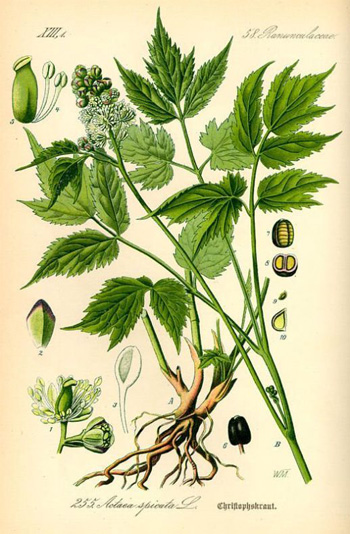Contents:
Common Names | Parts Usually Used | Plant(s) & Culture | Where Found | Medicinal Properties
Legends, Myths and Stories | Uses | Formulas or Dosages | Bibliography
Scientific Names

- Osmunda regalis L.
- Fern family
Common Names
- Buckhorn Brake
Parts Usually Used
Rootstock
Back to Top

Description of Plant(s) and Culture
Buckhorn brake is a perennial plant; the large, scaly rootstock is covered with matted fibers and often rises like a trunk up to a foot out of the ground. The pale green, bipinnate fronds have brown stalks and are ovate in outline; the oblong-elliptic pinnules are finely toothed. Sterile fronds are leafy only: fertile ones are topped by a tripinnate panicle of fertile pinnae which turn brownish in maturity and bear green spores. The fruiting axis bears black hairs. Fruiting time is from April to June.
Another variety: Cinnamon-colored fern or Cinnamon fern
Back to Top
Where Found
Grows in meadows and other moist areas, mostly in Europe, Great Britain, and Africa; a variety without hairs on the fruiting parts of the fronds grows in eastern North America.
Back to Top
Medicinal Properties
Mucilaginous, tonic
Back to Top
Legends, Myths and Stories
The mucilaginous extract from the rhizomes have in the past been a part of the druggists’ supply, but is now of doubtful value.
Back to Top
Uses
A decoction useful for coughs, jaundice if taken early, a tonic for convalescents. The mucilage makes a good ointment for sprains, bruises, and wounds; mixed with brandy it was once popular as a rub for backache.
Back to Top
Formulas or Dosages
Collect rootstock in late spring or late summer, and dry carefully.
Infusion or decoction: use
Tincture: a dose is from
Back to Top
Bibliography
![]() American Folk Medicine
American Folk Medicine, by Clarence Meyer, Meyerbooks, publisher, PO Box 427, Glenwood, Illinois 60425, 1973
![]() Culpeper’s Complete Herbal & English Physician: Updated With 117 Modern Herbs
Culpeper’s Complete Herbal & English Physician: Updated With 117 Modern Herbs, by Nicholas Culpeper, Meyerbooks, publisher, PO Box 427, Glenwood, Illinois 60425, 1990, (reprint of 1814)
![]() The Herbalist Almanac
The Herbalist Almanac, by Clarence Meyer, Meyerbooks, publisher, PO Box 427, Glenwood, Illinois 60425, copyright 1988, fifth printing, 1994
![]() The Herb Book
The Herb Book, by John Lust, Bantam Books, 666 Fifth Avenue, New York, NY. copyright 1974.
 Old Ways Rediscovered
Old Ways Rediscovered, by Clarence Meyer, Meyerbooks, publisher, PO Box 427, Glenwood, Illinois 60425, published from 1954, print 1988
 The Rodale Herb Book: How to Use, Grow, and Buy Nature’s Miracle Plants (An Organic gardening and farming book)
The Rodale Herb Book: How to Use, Grow, and Buy Nature’s Miracle Plants (An Organic gardening and farming book), edited by William H. Hylton, Rodale Press, Inc. Emmaus, PA, 18049., 1974
